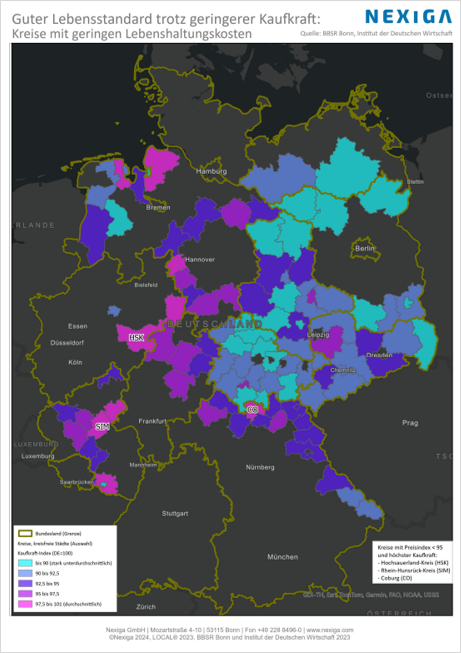Life is expensive in the German metropolises. According to a recent study, the cost of living in Germany varies considerably from region to region. A major factor here is housing costs, which account for a high share of consumer spending.
Not surprisingly, the costs are highest in economically strong cities, but there are also cities in the second row that are costly. A high income there does not necessarily mean high purchasing power.

Nexiga Purchasing Power 2024 - coming soon!
Overall, purchasing power data is a valuable tool for companies to make well-founded decisions in connection with locations and markets.

The data on purchasing power provides insights into the economic potential of a region and helps in the selection of suitable locations for stores or services.
-
Market analysis
Purchasing power data enables companies to analyze the market and identify potential customers. -
Location selection
Locations with high purchasing power are often more attractive as they offer greater customer potential. -
Pricing strategy
Companies can adapt their pricing strategy to the purchasing power of the target group. -
Marketing
Purchasing power data helps with the targeted placement of advertising and marketing campaigns. -
Expansion strategy
Companies can consider areas with similar purchasing power to existing locations.
Once a year, we calculate the forecast purchasing power for the whole of Germany at different geographical levels. The update for 2024 will be published shortly.
You can find more information about Nexiga purchasing power here.
Regional price indices
In most regions of Germany, the cost of living have risen overall. This is due to the general price increase (inflation), which affects many areas of daily life. These include food, energy, healthcare and mobility.
But it is above all the housing coststhat define regional price levels. Prices for food and clothing, on the other hand, fluctuate much less. This was shown last fall by a study of the German Economic Institute (IdW) with the BBSR (Federal Institute for Building, Urban Affairs and Spatial Planning), which developed a regional price index presented.
The FAZ reported in October and showed an overview map at the level of the 400 districts and independent cities. For example, the cost of living in Munich and Frankfurt am Main is around 25 and 16 percent above the national average respectively. Nowhere else is housing so expensive. But even in smaller and medium-sized university cities such as Freiburg and Heidelberg, which attract many people, living is comparatively expensive. The price index is high there, as the purchasing power is relatively low. Braunschweig is exactly at the national average. The capital Berlin is only slightly higher. The regions around Pirmasens (Rhineland-Palatinate) and Görlitz (Saxony) are very affordable places to live.
The most important finding from the study is that real disposable income, which takes local costs into account, varies less than nominal (absolute) income. This also puts the population's income and therefore purchasing power into perspective. For example, a lot is earned in Munich, but more has to be spent there than in rural regions with lower incomes, especially for the largest cost block "housing".
Where you can live cheaply
Our map (PDF) shows the 104 districts and independent cities that are assigned to the category "low price level" according to the study. This corresponds to an index value of 95 and below, corresponding to 5% or more below the national average. Exactly half of these districts are located in the eastern federal states, where about 7.9 million inhabitants live. In contrast, only about 5.7 million people live in the other 52 districts in the old federal states.
In the map, these circles are shown based on Nexiga purchasing power . Nexiga calculated a per capita purchasing power (disposable income) of EUR 25,877 for 2023.
Cities and regions in the new federal states (except Berlin and the surrounding area) often have a lower cost of living . Cities such as Leipzig, Dresden and Chemnitz offer a relatively high quality of life at comparatively moderate costs. Real purchasing power may be higher in these regions due to lower rents and cheaper prices for services and goods.
Disposable income is often higher in the 52 districts with a low price index in the western states. In some regions, such as the HochsauerlandCounty (NRW), Rhine-HunsrückCounty (Rhineland-Palatinate) or Coburg (Bavaria) therefore have a good ratio of cost of living to income , even if the purchasing power is at most in line with the national average (index values around 100). This is where the ratio of price index to purchasing power is most favourable.
It is important to note that the specific cost of living depends a lot on the individual situation , such as lifestyle and housing needs.
